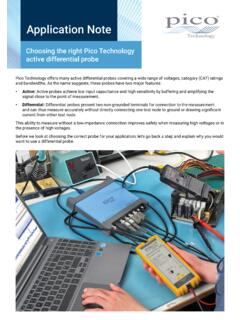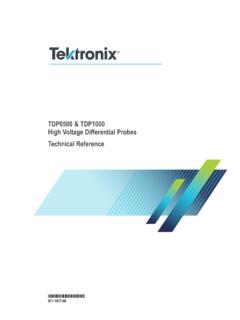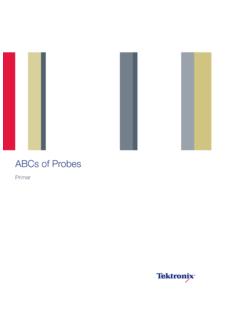Transcription of 70 MHz High-Voltage Differential Probe User’s Manual
1 DO139-2 Copyright 2008 2016 Pico Technology Ltd. 1 TA 0 44 70 MHz High-Voltage Differential Probe user s Manual This Probe complies with , Pollution Degree 2. Absolute max. voltage 7000 V (DC + Peak AC) or 5000 V RMS Differential 1. Safety terms and symbols Terms appearing in this Manual : WARNING Warning statements identify conditions or practices that could result in injury or death. CAUTION Caution statements identify conditions or practices that could result in damage to this product or other property. Symbols appearing on the product: Danger high voltage Protective (Earth) Terminal Attention Refer to Manual 2 Copyright 2008 2016 Pico Technology Ltd. DO139-2 2. General safety summary Please review the following safety precautions to avoid injury and prevent damage to this Probe or any products that are connected to it.
2 Observe maximum working voltage To avoid any injury, do not use the Probe above 2500 V RMS between each input lead and earth or above 5000 V RMS between the two input leads. Must be grounded This Probe is grounded with the shell of the BNC connector and an auxiliary grounding terminal. WARNING Before making connections to the input leads of this Probe , ensure that its output lead is grounded. You may do this either by connecting the BNC shell to a grounded measurement instrument, or by connecting the auxiliary grounding terminal to a reliable ground point. Read the next paragraph for further advice. You must verify that the Probe is securely grounded before connecting the Probe input leads. Some types of measuring instrument, such as a USB oscilloscope connected to a laptop, are unlikely to be grounded even if the laptop is powered from the mains.
3 Bench-top oscilloscopes are usually grounded, but in some cases may have been isolated from ground. A USB oscilloscope connected to a desktop computer is usually grounded. In any case, do not assume that the measurement instrument is grounded. Always verify the ground connection for yourself before connecting the Probe input leads. Use fused test prods if necessary If this Probe is intended to use for measurements in circuits of INSTALLATION CATEGORY III, it should incorporate with fused test prods. Do not operate without covers To avoid electric shock or fire hazard, do not operate this Probe with the covers removed. Do not operate in wet or damp conditions To avoid electric shock, do not operate this Probe in wet or damp conditions. Do not operate in explosive atmosphere To avoid injury or fire hazard, do not operate this Probe in an explosive atmosphere.
4 Avoid exposed circuitry To avoid injury, remove jewelry such as rings, watches and other metallic objects. Do not touch exposed connections and components when power is present. DO139-2 Copyright 2008 2016 Pico Technology Ltd. 3 Use proper power source To ensure proper functioning of this Probe , use four AA cells or a 6 V DC 200 mA mains adaptor or 9 V DC 120 mA mains adaptor or power leads. Do not operate the Probe if it is damaged If you suspect there is damage to this Probe , have it inspected by qualified service personnel. 3. Description By enabling conventional oscilloscopes to display and measure in-circuit waveforms that are referenced to high common-mode voltages, this Differential Probe extends the measurement capability of oscilloscopes to electronic power converters, inverters, motor speed controls, switch-mode power supplies and many other applications.
5 4. Installation a. Simply plug in the BNC output connector to the vertical input of a general-purpose oscilloscope or other measurement instrument, and connect the auxiliary grounding terminal to a proper ground. The measurement instrument must have a ground reference. b. Install four AA cells or connect an appropriate power source to this Probe . c. Select the proper attenuation ratio. When measuring signals below 700 V, switch the attenuation ratio to 1:100 in order to get higher resolution and less noise. Otherwise, set the attenuation to 1:1000. WARNING To protect against electric shock, use only the accessories designed for use with this Differential Probe . d. Using the appropriate Probe accessories, connect the input to the circuits under measurement.
6 CAUTION This Probe is designed for carrying out Differential measurements between two points on the circuit under test. It is not intended for electrically insulating the circuit under test and the measuring instrument. 4 Copyright 2008 2016 Pico Technology Ltd. DO139-2 5. Appearance The Differential Probe looks like this: 6. Power leads Two types of power leads are available for use with this instrument: a. Lemo Lead: For oscilloscopes with Lemo power connectors. b. Probus Lead: For oscilloscopes with Probus power connectors. A. Output Lead The BNC output connector and an auxiliary grounding terminal are connected to the oscilloscope. B. Input Leads The input leads of the Differential Probe connect to sprung hooks that come with the Probe . C.
7 Sprung Hooks The sprung hooks are connected safely to test points in the circuits under test. A B C Oscilloscope front panel DO139-2 Copyright 2008 2016 Pico Technology Ltd. 5 7. Specifications Bandwidth DC to 70 MHz (-3 dB) Attenuation ratio 1:100/1000 Accuracy 2% Input impedance 10 M 10 pF each side to ground Input voltage Differential range* (1/100) Max. Differential * (1/1000) 700 V (DC + Peak AC) or 700 V RMS 7000 V (DC + Peak AC) or 5000 V RMS Common mode range* 7000V (DC + Peak AC) or 2500 V RMS (1:100 and 1:1000) Absolute max. voltage * Common mode 7000 V (DC + Peak AC) or 2500 V RMS (1:100 & 1:1000) Differential mode 7000 V (DC + Peak AC) or 5000 V RMS (1:100 & 1:1000) Output voltage Swing 7V into 50 k load Offset (typical) < 5 mV Noise (typical) mV RMS Source impedance (typical) 50 CMRR (typical) -80 dB @ 60 Hz; -50 dB @ 1 MHz Ambient operating temperature -10 to 40 C Ambient storage temperature -30 to 70 C Ambient operating humidity 25 to 85% RH Ambient storage humidity 25 to 85% RH Power requirements Standard 4xAA cells or 6 V DC 200 mA mains adaptor** or regulated 9 V DC 120 mA mains adaptor** Options Power leads Length of input leads 60 cm Length of BNC lead 90 cm Weight 500 g Dimension (LxWxH) 202 mm x 83 mm x 38 mm * voltage limit is the lesser of the DC+Peak AC and RMS values.
8 ** a. The supplied voltage must be less than 12 V and greater than V, otherwise the Probe could be damaged or might not operate properly. b. Polarity is + inside and outside. If the polarity is wrong, a built-in circuit protects the Probe so that no danger or damage will occur. c. When the voltage of the cells becomes too low, the power indicator on the panel will flicker. 6 Copyright 2008 2016 Pico Technology Ltd. DO139-2 8. Derating curve The derating curve for absolute maximum input voltage is as follows: 9. Overrange indicator The overrange indicator lights up red if the voltage of the input signal exceeds the linear operating range of the Probe . When this happens, the signal on the Probe output may not accurately represent the signal on the Probe input. 10. Test procedure 1.
9 Connect the BNC output connector to the vertical input of a general-purpose oscilloscope. 2. Install four AA cells or connect an appropriate mains adaptor to this Probe . 3. Set the oscilloscope input coupling to DC and 1 V/div. Center the trace on the display. 4. Connect the sprung hooks of the Probe to power lines. 5. Set the range of the Probe to 1:100. 6. A 50 Hz / 60 Hz sine-wave of proper amplitude will be displayed on the screen of the oscilloscope. This means the Probe is working properly. + + + +08 Frequenc y (Hz) voltage (V rms) DO139-2 Copyright 2008 2016 Pico Technology Ltd. 7 11. Calibrating the unit There are three main sources of uncertainty when calibrating a Pico Differential Probe in addition to any uncertainty in the test setup. These are: 1. The stated DC accuracy of the Probe under test ( 2%).
10 2. Any DC offset or noise in the Probe output. The values in this Manual are typical, so to find the DC offset for a given unit a reading must be taken with the inputs to the Probe shorted together. 3. The AC performance of the Probe . This is specified as being within 3 dB over the entire frequency range of the Probe . Any absolute voltage accuracy testing must be done under DC conditions. One other possible source of noise is the power source for the Probe . It is recommended that where possible the probes are calibrated using a battery supply rather than a mains supply unit. The adjustment procedure is available from Pico Technology on request. 12. Cleaning Use a soft cloth to clean the Probe , taking care not to cause damage. a. Do not immerse the Probe . b. Do not use abrasive cleaners. c. Do not use chemicals contains benzene or similar solvents.












